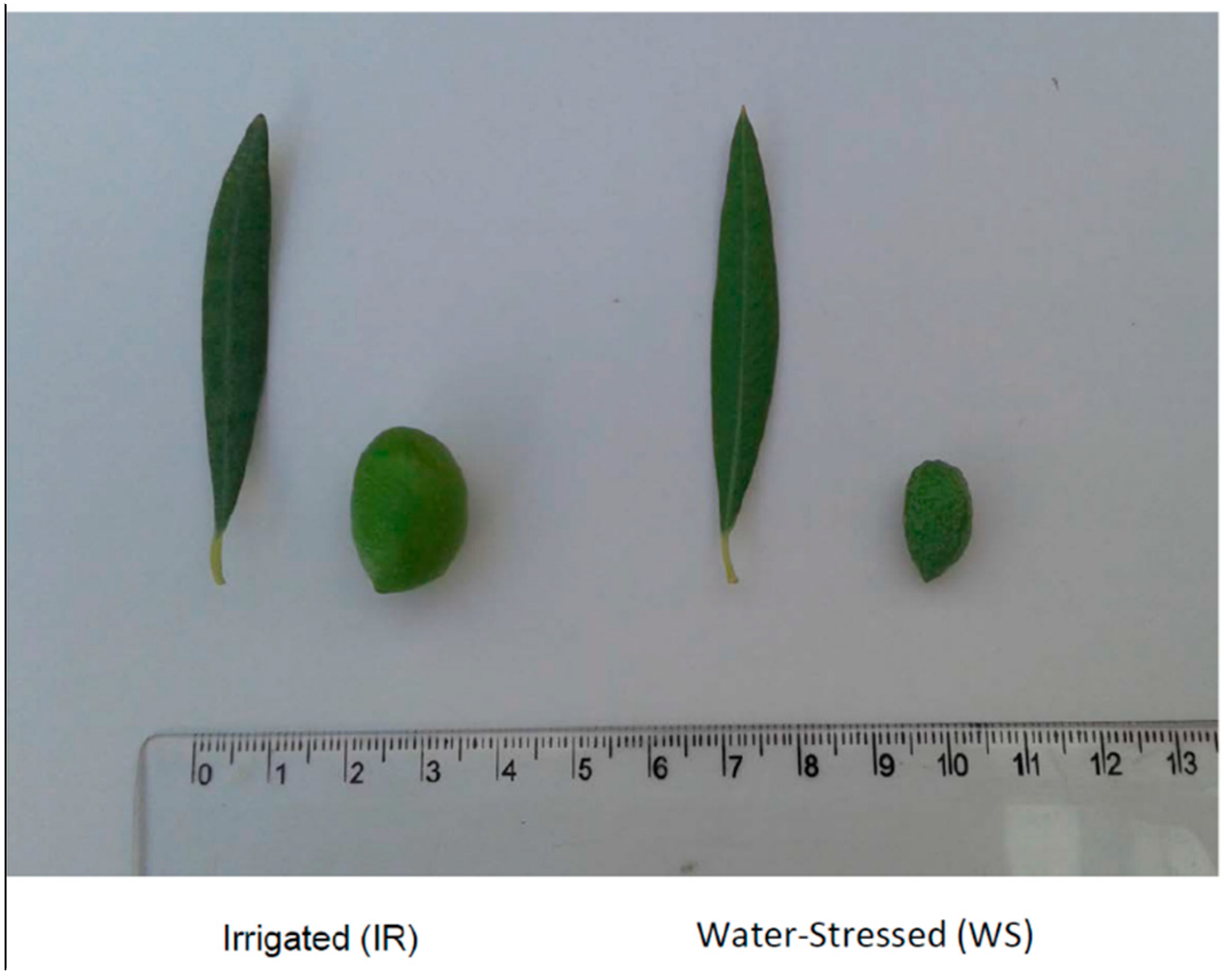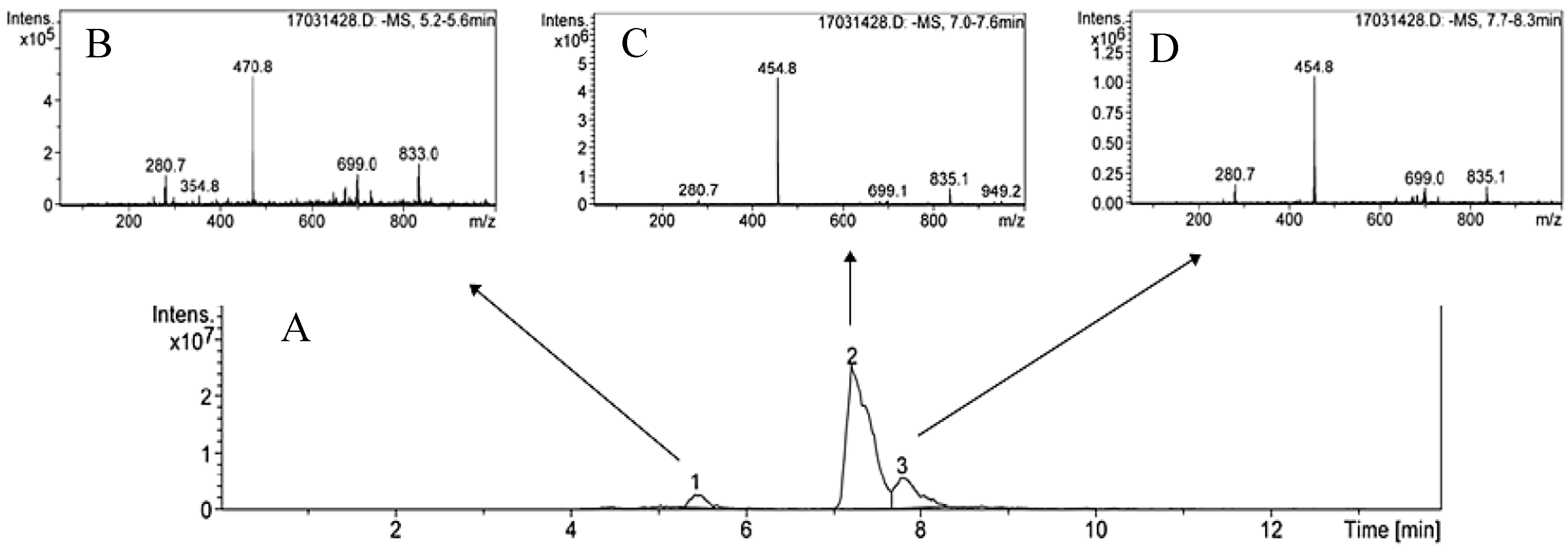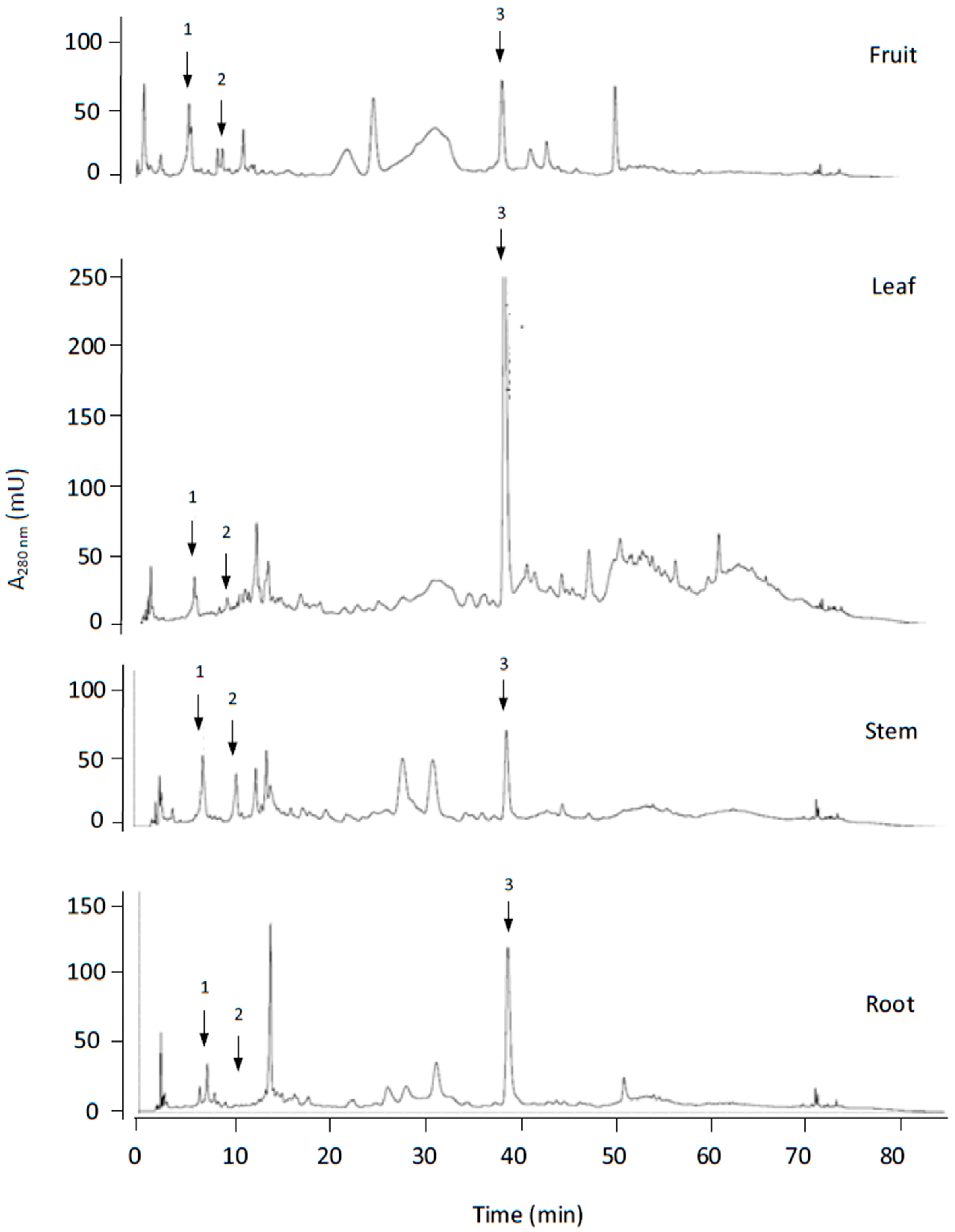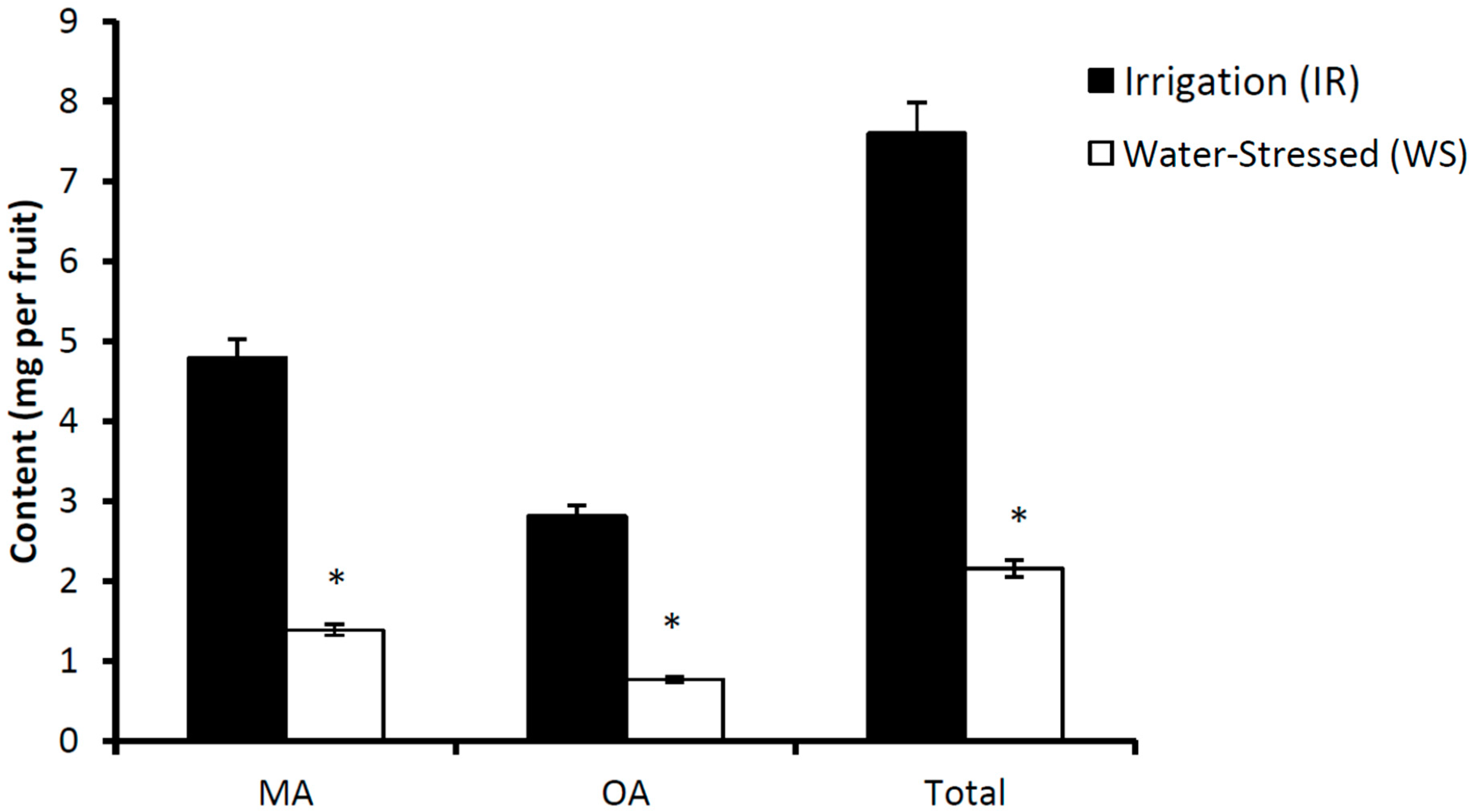Water Stress, Irrigation and Concentrations of Pentacyclic Triterpenes and Phenols in Olea europaea L. cv. Picual Olive Trees
Abstract
:1. Introduction
2. Materials and Methods
2.1. Drugs
2.2. Experimental Design, Olive Tree Material and Sampling
2.3. Extraction and Quantification of Triterpenic Compounds
2.4. Extraction and Quantification of Phenolic Compounds
2.5. Statistical Analysis
3. Results
4. Discussion
Author Contributions
Funding
Acknowledgments
Conflicts of Interest
Abbreviations
| EO | erythrodiol |
| HPLC-UV/Vis | ultraviolet-visible high-performance liquid chromatography system |
| HPLC-MS | mass high-performance liquid chromatography system |
| HTyr | hydroxytyrosol |
| IR | irrigated |
| MA | maslinic acid |
| OA | oleanolic acid |
| Ole | oleuropein |
| Tyr | tyrosol |
| UO | uvaol |
| WS | water-stressed |
References
- Trabelsi, L.; Gargouir, K.; Ben Hassena, A.; Mbadra, C.; Ghrab, M.; Ncube, B.; Van Staden, J.; Gargouri, R. Impact of drought and salinity on olive water status and physiological performance in an arid climate. Agric. Water Manag. 2019, 213, 749–759. [Google Scholar] [CrossRef]
- Calvo-Polanco, M.; Ruiz-Lozano, J.M.; Azcón, R.; Molina, S.; Beuzon, C.R.; García, J.L.; Cantos, M.; Aroca, R. Phenotypic and molecular traits determine the tolerance of olive tres to drought stress. Plant Physiol. Biochem. 2019, 139, 521–527. [Google Scholar] [CrossRef] [PubMed]
- Reddy, A.R.; Chaitanya, K.V.; Vivekanandan, M. Drought-induced responses of photosynthesis and antioxidant metabolism in higher plants. J. Plant Physiol. 2004, 161, 1180–1202. [Google Scholar] [CrossRef]
- Peleg, Z.; Blumwald, E. Hormone balance and abiotic stress tolerance in crop plants. Curr. Opin. Plant Biol. 2011, 14, 290–295. [Google Scholar] [CrossRef] [PubMed]
- Yang, W.; Liu, X.D.; Chi, X.J.; Wu, C.A.; Li, Y.Z.; Song, L.L.; Liu, X.M.; Wang, Y.F.; Wang, F.W.; Zhang, C.; et al. Dwarf Apple MbDREB1 enhances plant tolerance to low temperature, drought, and salt stress via both ABA-dependent and ABA-independent pathways. Planta 2011, 233, 219–229. [Google Scholar] [CrossRef] [PubMed]
- Calvo-Polanco, M.; Sánchez-Castro, I.; Cantos, M.; García, J.L.; Azcón, R.; Ruiz-Lozano, J.M.; Beuzón, C.R.; Aroca, R. Effect of different arbuscular mycorrizal fungal backgrounds and soils on olive plants growth and water relation properties under well-watered and drought conditions. Plant Cell Environ. 2016, 39, 2498–2514. [Google Scholar] [CrossRef] [PubMed]
- Girón, I.F.; Corell, M.; Galindo, A.; Torrecillas, E.; Morales, D.; Dell’Amico, J.; Torrecillas, A.; Moreno, F.; Moriana, A. Changes in the physiological response between leaves and fruits during a moderate water stress in table olive trees. Agric. Water Manag. 2015, 148, 280–286. [Google Scholar] [CrossRef]
- D’Andria, R.; Lavini, A.; Morelli, G.; Patumi, M.; Terenziani, S.; Calandrelli, D.; Fragnito, F. Effects of water regimes on ®ve pickling and double aptitude olive cultivars (Olea europaea L.). J. Hortic. Sci. Biotechnol. 2009, 79, 18–25. [Google Scholar]
- Gómez-Rico, A.; Salvador, M.D.; Fregapane, G. Virgin olive oil and olive fruit minor constituents as affected by irrigation management base don SWP and TDF as compared to ETc in médium-density young olive orchards (Olea europaea L cv. Cornicabra and Morisca). Food Res. Int. 2009, 42, 1067–1076. [Google Scholar] [CrossRef]
- Martinelli, F.; Basile, B.; Morelli, G.; d’Andria, R.; Tonutti, P. Effects of irrigation on fruit ripening behavior and metabolic changes in olive. Sci. Hortic. 2012, 144, 201–207. [Google Scholar] [CrossRef]
- Berenguer, M.J.; Vossen, P.M.; Grattan, S.R.; Connell, J.H.; Polito, V.S. Tree irrigation levels for optimum chemical and sensory properties of olive oil. HortScience 2006, 41, 427–432. [Google Scholar] [CrossRef]
- Gómez-Rico, A.; Salvador, M.D.; Moriana, A.; Perez, D.; Olmedilla, N.; Ribas, N.; Fregapane, G. Influence of different irrigation strategies in a traditional Cornicabra cv. Olive orchard of virgin olive oil composition and quality. Food Chem. 2007, 100, 568–578. [Google Scholar] [CrossRef]
- Stiti, N.; Triki, T.S.; Hartmann, M.A. Formation of triterpenoids throughout Olea europaea fruit ontogeny. Lipids 2007, 42, 55–67. [Google Scholar] [CrossRef] [PubMed]
- Covas, M.I.; Ruiz-Gutiérrez, V.; de la Torre, R.; Kafatos, A.; Lamuela-Reventós, R.M.; Osada, J.; Owen, R.W.; Visioli, F. Minor components of olive oil: Evidence to date of health benefits in humans. Nutr. Rev. 2006, 64, S20–S30. [Google Scholar] [CrossRef]
- Wang, D.; Xia, M.; Cui, Z. New triterpenoids isolated from the root bark of Ulmuls pumilla L. Chem. Pharm. Bull. 2006, 54, 775–778. [Google Scholar] [CrossRef] [PubMed]
- Montilla, M.P.; Agil, A.; Navarro, M.C.; Jiménez, M.I.; García-Granados, A.; Parra, A.; Cabo, M.M. Antioxidant activity of maslinic acid, a triterpene derivative obtained from Olea europaea. Planta Med. 2003, 69, 472–474. [Google Scholar] [PubMed]
- Yang, Z.G.; Li, H.R.; Wang, L.Y.; Li, Y.H.; Lu, S.G.; Wen, X.F.; Wang, J.; Daikonya, A.; Kitanaka, S. Triterpenoids from Hippophae rhamnoids, L. and their nitric oxide production-inhibitory and DPPH radical-scavenging activities. Chem. Pharm. Bull. 2007, 55, 15–18. [Google Scholar] [CrossRef] [PubMed]
- Márquez-Martín, A.; de la Puerta-Vázquez, R.; Fernández-Ache, A.; Ruiz-Gutiérrez, V. Suppressive effect of maslinic acid from pomace olive oil on oxidative stress and cytokine production in stimulated murine macrophages. Free Radic. Res. 2006, 40, 295–302. [Google Scholar]
- García-Granados, A.; Martínez, A.; Parra, A.; Rivas, F.; Osuna, A.; Mascaró, C. Use of Maslinic Acid as Inhibitor of a Serine Proteases for the Treatment of Diseases Caused by Parasites of the genus Cryptosporidium. Spanish Patent Application No. P9701029, 16 July 1999. [Google Scholar]
- Reyes-Zurita, F.J.; Rufino-Palomares, E.E.; Lupiáñez, J.A.; Cascante, M. Maslinic acid, a natural triterpene from Olea europaea L., induces apoptosis in HT29 human colon-cancer cells via the mitochondrial apoptotic pathway. Cancer Lett. 2009, 273, 44–54. [Google Scholar] [CrossRef]
- Rufino-Palomares, E.; Reyes-Zurita, F.; García-Salguero, L.; Mokhtari, K.; Medina, P.P.; Lupiáñez, J.A.; Peragón, J. Maslinic acid, a triterpenic anti-tumoural agent, interferes with cytoskeleton protein expression in HT29 human colon-cancer cells. J. Proteom. 2013, 83, 15–25. [Google Scholar] [CrossRef]
- Allouche, Y.; Uceda, M.; Jiménez, A.; Aguilera, M.P.; Gaforio, J.J.; Beltrán, G. Fruit quality and olive leaf and stone addition affect picual virgen olive oil triterpenic content. J. Agric. Food Chem. 2009, 57, 8998–9001. [Google Scholar] [CrossRef] [PubMed]
- Soler-Rivas, C.; Espín, J.C.; Wichers, H.J. Oleuropein and related compounds. J. Sci. Food Agric. 2000, 80, 1013–1023. [Google Scholar] [CrossRef]
- Manna, C.; Migliardi, V.; Golino, P.; Scognamiglio, A.; Galletti, P.; Chiariello, M.; Zappia, V. Oleuropein preents oxidative myocardial injury induced by ischemi and reperfusion. J. Nutr. Biochem. 2004, 15, 461–464. [Google Scholar] [CrossRef] [PubMed]
- Napolitano, A.; De Lucia, M.; Panzella, L.; d’Ischia, M. The chemistry of tyrosol and hydroxytyrosol: Implications for oxidative stress. In Olives and Olive Oil in Health and Disease Prevention; Preedy, V.R., Watson, R.R., Eds.; Elsevier Academic Press: London, UK, 2010; pp. 1225–1232. [Google Scholar]
- Chondrogianni, N.; Chinou, I.; Gonos, E. Anti-aging properties of the olive constituent oleuropein in human cells. In Olives and Olive Oil in Health and Disease Prevention; Preedy, V.R., Watson, R.R., Eds.; Elsevier Academic Press: London, UK, 2010; pp. 1335–1343. [Google Scholar]
- Peragón, J. Time course of pentacyclic triterpenoids from fruits and leaves of olive tree (Olea euopaea L.) cv. Picual and cv. Cornezuelo during ripening. J. Agric. Food Chem. 2013, 61, 6671–6678. [Google Scholar] [CrossRef] [PubMed]
- Ortega-García, F.; Peragón, J. Phenylalanine ammonia-lyase, polyphenol oxidase and phenols concentration in fruits of Olea europaea L. cv. Picual, Verdial, Arbequina, and Frantoio during ripening. J. Agric. Food Chem. 2009, 57, 10331–10340. [Google Scholar] [CrossRef]
- Ortega-García, F.; Peragón, J. Phenol metabolism in the leaves of the olive tree (Olea europaea L.) cv. Picual, Verdial, Arbequina, and Frantoio during ripening. J. Agric. Food Chem. 2010, 58, 12440–12448. [Google Scholar] [CrossRef] [PubMed]
- Masmoudi, M.M.; Nagaz, K.; Ben Mechlia, N. Perception of drought by farmers and its impact on farming and irrigation practices. In Options Mediterraneennes, Serie A. 9. Economics of Drought and Drought Preparedness in a Climate Change Context; Lopez-Francos, A., Ed.; CIHEAM: Zaragoza, Spain, 2010; pp. 323–327. [Google Scholar]
- Dichio, B.; Xiloyannis, C.; Sofo, A.; Montarano, G. Osmotic regulation in leaves and roots of olive trees during water deficit and rewatering. Tree Physiol. 2006, 26, 179–185. [Google Scholar] [CrossRef]
- Perrone, I.; Pagliarani, C.; Lovisolo, C.; Chitarra, W.; Roman, F.; Schubert, A. Recovery from water stress affects grape leaf petiole transcriptome. Planta 2012, 235, 1383–1396. [Google Scholar] [CrossRef]
- Miranda-Fernandez, R.D.; Cuevas, M.V.; Diaz-Espejo, A.; Hernandez-Santana, V. Effects of water stress on fruit growth and water relations between fruits and leaves in a hedgerow olive orchard. Agric. Water Manag. 2018, 210, 32–40. [Google Scholar] [CrossRef]
- Yogeeswari, P.; Sriram, D. Betulinic acid and its derivatives: A review on their biological properties. Curr. Med. Chem. 2005, 12, 657–666. [Google Scholar] [CrossRef]
- Liu, C.; Chen, Y.; Lu, C.; Chen, H.; Deng, J.; Yan, Y.; Xu, Y.Y.; Liu, H.; Huang, H.; Wei, J.; et al. Betulinic acid suppresses Th17 response and ameliorates psoriasis-like murine skin inflammation. Int. Immunopharmacol. 2019, 73, 343–352. [Google Scholar] [CrossRef] [PubMed]








| Parameter | Irrigation (IR) | Water-Stressed (WS) |
|---|---|---|
| Ripeness index | 0.50 ± 0.03 | 0.50 ± 0.02 |
| Fruit weights (g) | 2.32 ± 0.13 | 0.83 ± 0.03 * |
| Stone weights (g) | 0.68 ± 0.03 | 0.43 ± 0.01 * |
| Pulp weights (g) | 1.64 ± 0.12 | 0.39 ± 0.03 * |
| Seed weights (g) | 0.05 ± 0.01 | 0.05 ± 0.01 |
| Humidity of fruits (%) | 55.00 ± 3.03 | 42.42 ± 0.07 * |
| Humidity of leaves (%) | 48.18 ± 0.05 | 35.05 ± 0.30 * |
| Humidity of stems (%) | 45.56 ± 1.02 | 37.11 ± 0.04 * |
| Humidity of roots (%) | 42.44 ± 0.89 | 34.05 ± 1.39 * |
| Compound | Fruit | Leaf | Stem | Root | ||||
|---|---|---|---|---|---|---|---|---|
| Irrigation (IR) | Water-Stressed (WS) | Irrigation (IR) | Water-Stressed (WS) | Irrigation (IR) | Water-Stressed (WS) | Irrigation (IR) | Water-Stressed (WS) | |
| Maslinic acid mg/g dry weight | 6.00 ± 0.30 | 8.39 ± 3.53 * | 3.28 ± 0.53 | 2.98 ± 0.22 | 2.10 ± 0.13 | 1.82 ± 0.28 | 0.015 ± 0.004 | 0.016 ± 0.008 |
| mg/g fresh weight | 2.91 ± 0.20 | 3.53 ± 0.33 * | 1.81 ± 0.44 | 1.36 ± 0.16 | 1.02 ± 0.08 | 1.00 ± 0.27 | 0.008 ± 0.003 | 0.010 ± 0.006 |
| Oleanolic acid mg/g dry weight | 3.13 ± 0.16 | 4.20 ± 0.30 * | 18.92 ± 2.61 | 21.83 ± 2.31 | 7.17 ± 0.58 | 6.30 ± 0.78 | 0.060 ± 0.021 | 0.051 ± 0.022 |
| mg/g fresh weight | 1.71 ± 0.08 | 1.98 ± 0.26 | 10.00 ± 1.36 | 10.50 ± 2.44 | 3.38 ± 0.37 | 2.99 ± 0.93 | 0.032 ± 0.013 | 0.031 ± 0.015 |
| Betulinic acid g/g dry weight | nd | nd | nd | nd | nd | nd | 1.133 ± 0.382 | 1.013 ± 0.370 |
| mg/g fresh weight | nd | nd | nd | nd | nd | nd | 0.627 ± 0.013 | 0.604 ± 0.271 |
| Erythrodiol mg/g dry weight | nd | nd | 0.92 ± 0.30 | 1.29 ± 0.21 | 1.00 ± 0.05 | 0.47 ± 0.14 * | nd | nd |
| mg/g fresh weight | nd | nd | 0.48 ± 0.14 | 0.58 ± 0.10 | 0.47 ± 0.04 | 0.24 ± 0.12 * | nd | nd |
| Uvaol mg/g dry weight | nd | nd | 2.05 ± 0.48 | 2.88 ± 0.44 | 0.31 ± 0.06 | 0.29 ± 0.07 | nd | nd |
| mg/g fresh weight | nd | nd | 0.48 ± 0.11 | 1.34 ± 0.12 * | 0.15 ± 0.03 | 0.16 ± 0.06 | nd | nd |
| Compound | Fruit | Leaf | Stem | Root | ||||
|---|---|---|---|---|---|---|---|---|
| Irrigation (IR) | Water-Stressed (WS) | Irrigation (IR) | Water-Stressed (WS) | Irrigation (IR) | Water-Stressed (WS) | Irrigation (IR) | Water-Stressed (WS) | |
| Oleuropein mg/g dry weight | 12.27 ± 1.60 | 153.21 ± 0.51* | 62.00 ± 0.63 | 49.20 ± 3.07 * | 8.42 ± 0.01 | 92.04 ± 0.23 * | 62.05 ± 0.31 | 43.86 ± 0.05 * |
| mg/g fresh weight | 7.04 ± 0.65 | 85.80 ± 0.29 | 32.00 ± 0.32 | 33.48 ± 2.12 | 4.57 ± 0.01 | 59.00 ± 0.15 * | 36.86 ± 0.19 | 31.23 ± 0.04 |
| Tyrosol mg/g dry weight | 0.62 ± 0.05 | 0.88 ± 0.02 * | 0.18 ± 0.02 | 0.27 ± 0.05 | 1.29 ± 0.09 | 0.78 ± 0.05 * | 0.07 ± 0.01 | 0.14 ± 0.01 * |
| mg/g fresh weight | 0.26 ± 0.02 | 0.50 ± 0.01 * | 0.09 ± 0.01 | 0.17 ± 0.04 | 0.72 ± 0.05 | 0.47 ± 0.05 * | 0.04 ± 0.01 | 0.10 ± 0.01 * |
| Hydroxytyrosol mg/g dry weight | 1.81 ± 0.03 | 1.17 ± 0.17 * | 0.69 ± 0.05 | 0.39 ± 0.05 * | 1.34 ± 0.02 | 1.39 ± 0.08 | 0.71 ± 0.12 | 0.59 ± 0.03 |
| mg/g fresh weight | 0.73 ± 0.02 | 0.44 ± 0.05 * | 0.36 ± 0.02 | 0.24 ± 0.04 * | 0.73 ± 0.01 | 0.89 ± 0.05 | 0.41 ± 0.06 | 0.41 ± 0.01 |
© 2019 by the authors. Licensee MDPI, Basel, Switzerland. This article is an open access article distributed under the terms and conditions of the Creative Commons Attribution (CC BY) license (http://creativecommons.org/licenses/by/4.0/).
Share and Cite
Jiménez-Herrera, R.; Pacheco-López, B.; Peragón, J. Water Stress, Irrigation and Concentrations of Pentacyclic Triterpenes and Phenols in Olea europaea L. cv. Picual Olive Trees. Antioxidants 2019, 8, 294. https://doi.org/10.3390/antiox8080294
Jiménez-Herrera R, Pacheco-López B, Peragón J. Water Stress, Irrigation and Concentrations of Pentacyclic Triterpenes and Phenols in Olea europaea L. cv. Picual Olive Trees. Antioxidants. 2019; 8(8):294. https://doi.org/10.3390/antiox8080294
Chicago/Turabian StyleJiménez-Herrera, Raquel, Beatriz Pacheco-López, and Juan Peragón. 2019. "Water Stress, Irrigation and Concentrations of Pentacyclic Triterpenes and Phenols in Olea europaea L. cv. Picual Olive Trees" Antioxidants 8, no. 8: 294. https://doi.org/10.3390/antiox8080294






